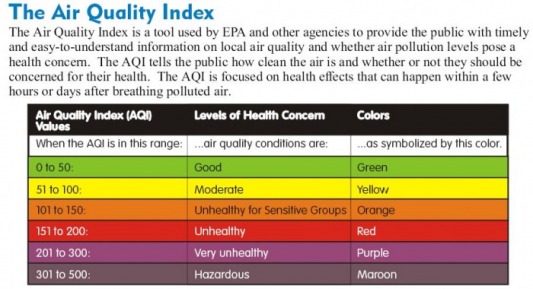Air quality index
The Air Quality Index, or AQI, is the standard system that state and local air pollution control programs use to notify the public about levels of air pollution. The AQI tracks levels of two pollutants-ozone (smog) and particle pollution (tiny particles from ash, vehicle exhaust, soil dust, pollen, and other pollution). AQI levels are reported in newspapers, radio, television, and web sites. AQI levels are reported year-round, as particle pollution can be a health threat any month. Ozone is a particular problem from May through October, depending on your region's weather. Particle pollution is often highest in the west in the winter and in the east in the summer.
Keeping track of the current air quality information can help you plan your activities year-round so that you can takes steps to protect yourself, children, and others to unhealthy levels of air pollution. This is especially important for people who are sensitive to air pollution, including children, people with asthma and other lung diseases, the elderly, as well as those who exercise outdoors--who may view themselves as "too healthy" to be affected by smog or particle pollution. Particle pollution can be especially dangerous to those with cardiovascular diseases, like heart attacks, high blood pressure, or strokes or with diabetes. Bottom line: breathing dirty air can affect anyone-both immediately and in the long-run!
How Does the Air Quality Index Work?
In over 700 counties across the nation, air pollution levels are measured daily and ranked on a scale of 0 for pristine air all the way up to 500 for air pollution levels that pose immediate danger to the public (fortunately, we do not have pollution levels that high in this country any more). The AQI further breaks air pollution levels into six categories, each of which has a descriptor (name), an associated color, and advisory statements to go along with it.

